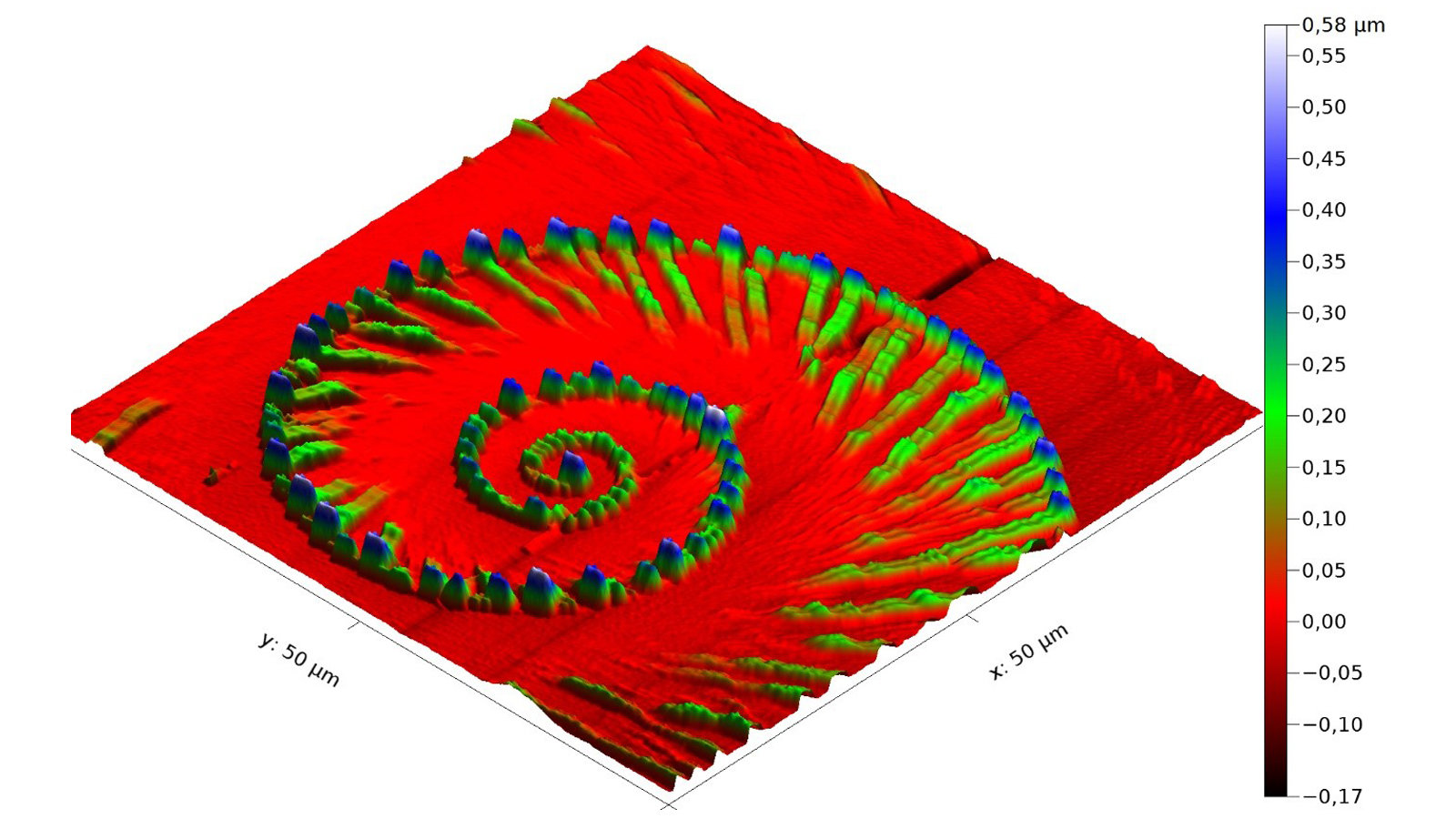Explosive crystallization produces spiral microstructures
Researchers of the Chemnitz University of Technology, the Helmholtz-Zentrum Dresden-Rossendorf, and the Leibniz Institute IFW-Dresden discover self-organizing, spiral microstructures.
-

Atomic force microscope image of the topography of logarithmic crystallized germanium-manganese of type II. Due to the observed surface structures the crystallization path can be subsequently reconstructed. Photo: Chemnitz University, Helmholtz-Zentrum Dresden-Rossendorf, Leibniz Institute IFW-Dresden
On larger scale, crystallization of snow crystals lead to beautiful patterned structures but crystallization processes also plays a fundamental role in various technological fields, including the semiconductor industry. Thus, the detailed understanding of crystallization is an important element in technology development. Scientists of the professorship Material Systems for Nanoelectronics at the Chemnitz University of Technology together with researchers of the Helmholtz-Zentrum Dresden-Rossendorf and the Leibniz Institute IFW in Dresden describe in the American “Journal of Applied Physics” a new type of “explosive crystallization”. The term refers to the real phenomenon of the explosion. The ignition takes place by a hotspot on the surface, similar to an ignition spark in a combustion engine. This form of crystallization affects amorphous materials that are often metastable, meaning that they have a higher energy from the energetic point of view but are unable to crystallize directly due to an energetic barrier and thus cannot transform into a lower state of energy. For this purpose an ignition spark is necessary.
In the present case, a flash lamp have been activated in order to cause a high temperature increase in a thin layer of germanium-manganese, in which the researchers already found in previous investigations self-organizing structures. Small existing droplets on the surface created so-called hotspots during the light pulse, which are small areas with an increased energy absorption resulting in an overheating and served as “ignition spark” for the subsequent explosion. Usually, circular expansions of the crystallized areas are to be expected. But this was not the case in the present material system: “There were centers which showed a preferred direction of crystallization. Responsible for this observation is probably the manganese which increasingly concentrates in an extreme thin, fluid zone at the crystallization front”, explains Danilo Bürger, postdoc at the Professorship for Material Systems for Nanoelectronics. The fluid zone with increased manganese concentration shows a significantly reduced melting temperature, thus a small direction-indicating perturbation on the surface could be sufficient to start directional crystallization.
A fascinating feature of the observed microstructure is the conclusion that the “corners” of the directional crystallization front follow the special path of the so-called logarithmic spiral. This type of spiral has special characteristics, including the so-called “self-similarity”. That means logarithmic spirals do not change their underlying structure when zooming in or zooming out. Logarithmic spiral structures are also appearing in nature: Biological objects like some plants or snails develop these structures. In the physics of condensed matter, in contrast to elementary particle physics or atomic physics, the appearance of logarithmic spirals is a very uncommon phenomenon. In the present case, for the development of the logarithmic spiral a complex interaction between reaction and diffusion processes is required. Far away from the ignition point of spiral type I, the expansion of the crystallization front changes back to the expected circular structure. This suggests the good correlation of the theoretically calculated and visible boundary of two meeting crystallization fronts from different hotspots.
That this type of self-organized pattern formation, generated with annealing technologies of the semiconductor industry, remained unnoticed up to now, is according to the researchers not unusual due to the specific production parameters but offers now new research opportunities for the deeper understanding of explosive crystallization processes.
Original publication:
Bürger et al., Journal of Applied Physics 121, 184901 (2017): http://dx.doi.org/10.1063/1.4983068
Further information: Dr. Danilo Bürger, Professorship for Material Systems for Nanoelectronics at the Chemnitz University of Technology, email: danilo.buerger@etit.tu-chemnitz.de , phone +49 371 531 32889
Matthias Fejes
13.06.2017




